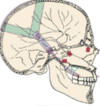Biology of Tooth Movement Flashcards
Periodontal Ligament
primarily made of collagenous fiber bundles
primary cells are fibroblasts which makes the collagen
the ligament is constantly remodeled: also by fibroblasts
Cellular elements
principal cellular elements of PDL, are undifferentiated mesenchymal cells and their progent in the form of fibroblasts and osteoblasts
other cells include: osteoclasts, cementoclasts. they all proliferate at different stages of tooth movement
Bone
adaptive and responsive character of bone is the main determinant in orthodontic tooth movement
tooth cannot move unless both bone apposition and resorption take place
structure: primarily collagen type I, hydroxyapatite
Osteoblasts
originate from marrow stromal cell lineage
bone forming cells: they appear at bone remodeling sites where osteoclasts previously resorbed bone
participate in minerialization process
Osteocytes
osteoblats that remian after bone formation stopped
occupy small lacunae w/in minerialized matrix of bone
Osteoclasts
originate from hematopoietic mononuclear stem cells
multinucleated
resorb bone
Alveolar bone proper
part of alveolar bone that lines the sockets
it is a thin lamella of compact bone in which periodontal fibers are embedded
specialized type of compact bone composed of bundle bone and haversian bone
referred to as bundle bone bc it incorporated Sharpey’s fibers of the perio ligament
Bio-electric theory
relates tooth movement at least in part to changes in bone metabolism controlled by the electric signals that are produced when alveolar bone flexes and bends
first and second messengers stimulate cellular change
Effects of Force Magnitude
There will be no tooth movement unless there is a force.
The response to sustained forces against the teeth is a function of force magnitude
Light continuous forces are compatible w/ the survival of cells w/in the PDL and a remodeling of the tooth socket by a relatively painless “frontal resorption” of the tooth socket
Frontal Resorption
facilitates orthodontic tooth movement, whereas undermining resorption delays orthodontic tooth movement
Optimal Pressure
minimal pressure causing maximal tooth movement. Varies for each tooth based on root surface
Intrusion
10 - 20 gm

Translation or bodily movement
70 to 120 g

Force Types
Light, continuous forces - never declines to zero
interrupted forces - declines to zero
Intermittent forces - declines to zero (removable appliances)

Force Duration
Threshold - 6 hrs per day
No tooth movement if forces are applied less than 6 hrs/day
From 6 to 24 hrs/day, the longer the force is applied, the more the teeth will move

Anchorage
Newton’s Law: for every action, there is a reaction
defined: resistance to unwanted tooth movement
anchorage value: any tooth is roughly equivalent to its root surface area. Thus, molars and canines generally have higher anchorage values than incisors and bicuspids
Reciprocal anchorage
both units move roughly equal distance
exemplified by closing a diastema between two central incisors

Reinforced anchorage
Unit A has substantially more anchorage value than Unit B. Thus, Unit A moves little but Unit B moves a lot.
Exemplified by retracting anterior teeth to close an extraction space by using posterior teeth as a reinforced anchorage unit

Stationary anchorage
bodily movement of the posterior teeth (needs larger force level vs. tipping of the anterior teeth.
posterior teeth do not move while anterior teeth move

Cortical Anchorage
Loss of teeth leads to loss of alveolar bone and replaced with cortical bone and thus makes it harder to move the posterior teeth forward

Skeletal Anchorage
head gear: not the best because it is not worn all the time

Stationary anchorage: TAD (temporary anchorage device)
micro screws placed in the cortical bone can provide absolute anchorage

potential complications of orthodontic tooth movement
the pulp
root resorption
alveolar bone height
orthodontic effects on the pulp
rare if light, continous forces are applied
occasional loss of tooth vitality - history of previous trauma, excessive orthodontic forces, moving roots against cortical bone
endodontically treated teeth can be moved like natural teeth with proper management
root resorption
more accurately, resorption of root cementum and dentin
normal ageing process in many individuals
likely occuring in many cases but not to the degree of clinical significance
root resorption induced by light orthodonttic forces is reversible (by regeneration and repair of cementum and/or dentin)
can lead to tooth mobility in severe cases
generalized root resorption
affects most, if not all teeth: maxillary incisors more susceptible than other teeth
could be moderate or severe but commonly in the range of up to 2.5mm
etiology largely unknown but predisposing factors include conical roots with pointed apices, distorted tooth form, or a history of trauma
Prostaglandin inhibitors
prolonged use of corticosteroids or NSAIDS such as aspirin, ibuprofen may affect tooth movement by inhibiting prostaglandin synthesis, a mediator of tooth movement


